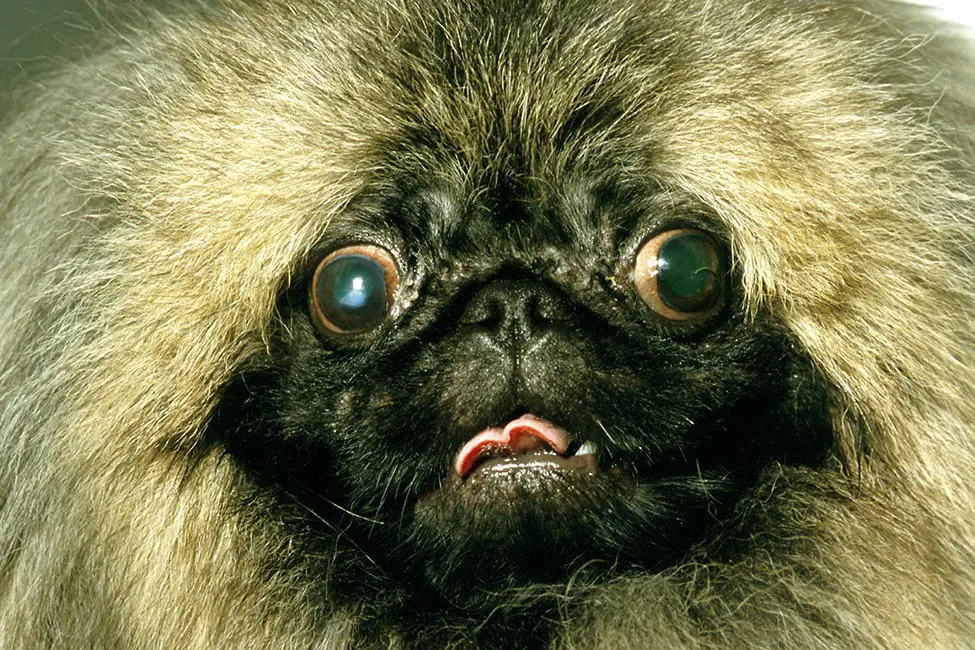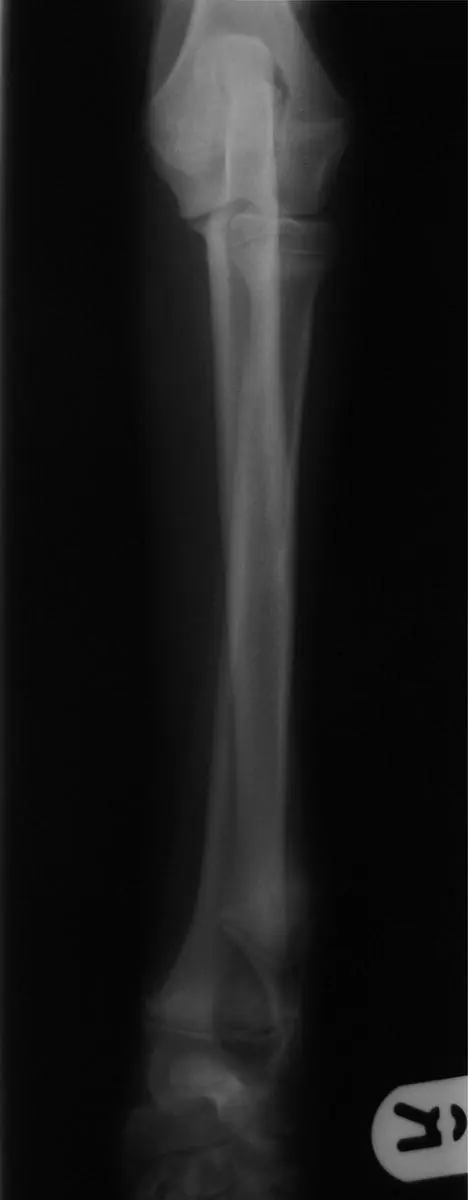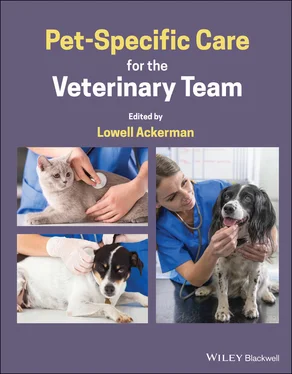Because the sire is clear, he must be homozygous for the normal allele (PP). The bitch, as a carrier, has the heterozygous genotype Pp. A mating of these two would produce roughly 50% homozygotes (PP) and 50% carriers (Pp), but no affected individuals (pp). Given the new technology, which allows genotypic determination for this trait in cocker spaniels, the occurrence of affected individuals can be completely eliminated even when it may be difficult to completely eliminate the recessive allele itself from a population.
 TAKE‐AWAYS
TAKE‐AWAYS
The best way to predict disease is to first create a risk profile.
The main risk factors for disease are often attributable to genetics, environmental, and lifestyle characteristics, and existing conditions that can lead to co‐morbidities.
Early detection of disease depends on both genotypic and phenotypic testing.
It is important to realize that it is not possible, or even advisable, to use predictive tests to try to eliminate all deleterious alleles from a breeding line.
Bias exists in most forms of research citing predisposition to disease; the information still has validity, but needs to be appreciated in context.
 MISCELLANEOUS
MISCELLANEOUS
Abbreviation
DNADeoxyribonucleic acid
1 Ackerman, L. (2011). The Genetic Connection: A Guide to Health Problems in Purebred Dogs, 2e. Lakewood, CO: AAHA Press.
2 Ackerman, L. (2019). The skinny on genes: what you should know about genetic testing. AAHA Trends 35 (6): 39–42.
3 Ackerman, L. (2020). Proactive Pet Parenting: Anticipating pet health problems before they happen. Problem Free Publishing.
4 Baker, L., Muir, P., and Sample, S.J. (2019). Genome‐wide association studies and genetic testing: understanding the science, success, and future of a rapidly developing field. Journal of the American Veterinary Medical Association 255 (10): 1126–1136.
5 Bell, J., Cavanagh, K., Tilley, L., and Smith, F. (2012). Veterinary Medical Guide to Dog and Cat Breeds. Jackson, WY: Teton NewMedia.
6 Shaffer, L.G., Geretshlaeger, A., Ramirez, C.J. et al. (2019). Quality assurance checklist and additional considerations for canine clinical genetic testing laboratories: a follow‐up to the published standards and guidelines. Human Genetics: 501–508.
3.5 Conformation Extremes and the Veterinary Team
Emma Goodman Milne, BVSc, M RCVS
Inde pendent Veterinary Surgeon, France
 BASICS
BASICS
3.5.1 Summary
In many countries around the world, breeds of pet animals, notably dogs, cats, and rabbits, are becoming more and more extreme in their body shapes. Examples of such extremes could be short legs, long backs, very long ears, excessive hair or hairlessness, pronounced skinfolds, bulging or sunken eyes and, perhaps the most well‐recognized, the brachycephalic or flat‐faced animals. All these extremes lean away from natural selection and evolution and can be associated with a wide spectrum of disease and life‐altering issues. These range from very mild to immediately life‐threatening. The veterinary team can make a big difference both throughout the animal's life but also by being involved right from the point of prepurchase decision making.
Conformation:The shape or dimensions of an animal.
Entropion:An eyelid that turns inwards and rubs on the eyeball.
Exophthalmos:Abnormal bulging or protrusion of the eyeball.
Inbreeding:The breeding of closely related individuals.
Pyoderma:An infection in the skin.
 MAIN CONCEPTS
MAIN CONCEPTS
3.5.3 The Origin of the Problem
For thousands and thousands of years, humans have lived with animals. We gradually selected different types of dogs to do different jobs like herding, hunting, and guarding. We chose different sizes and selected for different temperaments depending on what the dog needed to do. Cats did what they were good at – rodent control – so have been left largely unchanged until the last century or so. When the idea of different breeds and the purity of the breed lines became popular at the end of the 1800s, body shapes started to change and inbreeding became commonplace. Over the last 100–200 years, many breeds have become more and more extreme ( Figures 3.5.1and 3.5.2). For example, pugs and bulldogs that had notable muzzles in 1900 now have very flat faces indeed. Breeds that were created to have slightly shorter legs, like dachshunds and bassets, for hunting different prey now have extremely short legs compared to their back length.

Figure 3.5.1 Flat‐faced animals may experience a large number of health problems, some of which are life‐threatening.
Source: Photo courtesy of Dr David Gould.

Figure 3.5.2 Excessive skinfolds cause disease and eye problems.
Source: Photo courtesy of Dr David Gould.
During this time, we have become more and more used to the fact that different breeds are more likely to have certain health problems than others. Many of these breed‐related problems are due to unnatural and extreme body shape or conformation ( Figures 3.5.3and 3.5.4).

Figure 3.5.3 Short legs of a bassett compared to…
Source: Photo courtesy of Andy Moores.

Figure 3.5.4 …a normal straight leg.
Source: Photo courtesy of Andy Moores.
3.5.4 Consequences of Extreme Conformation
We know that the more extreme the body shape or individual features become, the more likely the animal is to suffer from health issues, but it is not just the animals that are affected. The emotional and financial consequences for the owners can be huge but the whole veterinary team can also be affected. It can be emotionally difficult for members of the hospital team to see and treat animals that are suffering due to their conformation, especially when the animals are young. We can become attached to clients we see often and seeing them deal with illness and death can have a huge effect on us too.
Читать дальше

 TAKE‐AWAYS
TAKE‐AWAYS MISCELLANEOUS
MISCELLANEOUS BASICS
BASICS MAIN CONCEPTS
MAIN CONCEPTS














